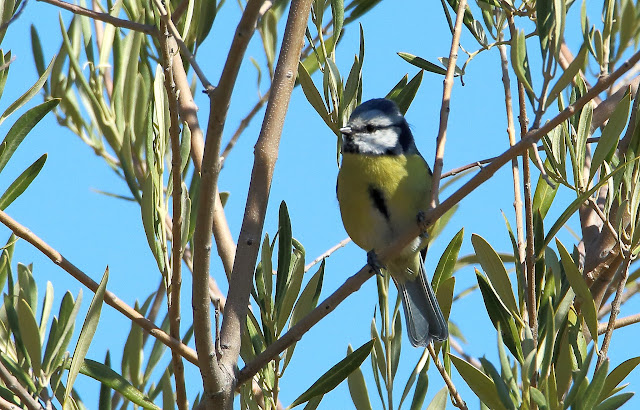Hola otra vez.
Hello again.
Esta semana os muestro algunas aves vistas en algunos Parques públicos de Madrid. Es interesante ver como algunas especies de aves como los pitos reales (Picus
viridis sharpei) y los picogordos (Coccothraustes
coccothraustes) son mucho más confiados que en la naturaleza.
This week I show you some Birds seen in some Public Parks of Madrid. It is interesting how some species of Birds such as Green Woodpecker and Hawfinch are much more confident than in nature.
Los parques además de tener bastantes aves son muy bonitos y el paseo merece la pena. Uno de los más bonitos con gran vegetación son los Jardines del Campo del Moro a los pies del Palacio Real.
In addition of having many Birds the Parks are beautiful and worth the walk. One of the most beautiful with great vegetation are the Campo del Moro Gardens at the feet of the Royal Palace.
Jardines del Campo del Moro.
Campo del Moro Gardens.
El Palacio Real. Esta es la fachada que mira a los Jardines.
The Royal Palace. This is the facade that overlooks the Gardens.
Una hembra de pito real (Picus
viridis sharpei). En la naturaleza suelen salir volando en cuanto te ven pero en los parques se acostumbran bastante a las personas y no son tan asustadizos.
A female of Green Woodpecker. In nature usually they fly away as soon as they see you but in the Parks they are quite accustomed to humans and are not so skittish.
Otra hembra.
Another female.
Macho.
Male.
Durante el invierno se pueden ver zorzales comunes (Turdus
philomelos).
During winter you can watch Song
Thrushes.
Gaviota sombría (Larus
fuscus).
Lesser
Black-backed Gull.
Garza real (Ardea
cinerea).
Grey
Heron.
Galápago de orejas amarillas (Trachemys scripta scripta) que la gente suelta en los lagos cuando no saben que hacer con ellas.
Yellow-bellied Slider that people release in lakes when they know not to do with them.
Un híbrido de pato domestico con pato criollo.
A hybrid of domestic Duck x Muscovy Duck.
Había varios ejemplares de pato criollo (Cairina moschata domestica).
There were several specimens of Muscovy Ducks.
No podían faltar las palomas domésticas (Columba livia domestica).
It could not lack Domestic Pigeons.
Algunos machos de ánade azulón (Anas
platyrhynchos) aun no tenían su plumaje nupcial.
Some males of Mallards still did not have their breeding plumage.
Sin embargo otros ya estaban con sus mejores galas.
But others were already in their best clothes.
Hembra.
Female.
Era tiempo de paso de grullas comunes (Grus grus) y me entretuvieron mucho.
It was time of the Common Cranes migration and entertained me very much.
Algunas pasaron relativamente bajas.
Some went relatively low.
Lavandera blanca (Motacilla
alba).
White
Wagtail.
Carbonero garrapinos (Periparus
ater).
Coal Tit.
Curruca cabecinegra (Sylvia
melanocephala) macho.
Male of Sardinian
Warbler.
Cormorán grande (Phalacrocorax
carbo).
Great
Cormorant.
Herrerillo común (Cyanistes
caeruleus).
Blue Tit.
Urraca (Pica pica).
Common Magpie.
Había muchas cotorras argentinas (Myiopsitta
monachus) que a pesar de ser una especie invasora y ruidosa a mí me gustan mucho. También vi un par de cotorras de kramer (Psittacula
krameri) pero muy rápidas para poder tomarlas una foto.
There were many Monk Parakeets that despite being an invasive specie and very noisy they like me a lot. I also saw a couple of Rose-ringed Parakeet but very quick to take them a picture.
Un arco iris que se formaba con las gotas de agua de una fuente.
A rainbow formed with drops of water from a fountain.
Gallineta común (Gallinula
chloropus).
Moorhen.
Garceta común (Egretta
garzetta).
Little
Egret.
Cada invierno aumenta el número de cigüeñas blancas (Ciconia ciconia) que no emigran.
Every winter increases the number of White Storks that do not migrate.
En los Jardines Campo del Moro se pueden ver algunas aves de Parque. En la foto una hembra de pavo real (Pavo cristatus).
In the Gardens of Campo del Moro you can see some Birds Park. In the picture a Peacock female.
Macho.
Male.
A los machos les estaban creciendo sus hermosas plumas de cortejo.
The beautiful courtship feathers of males were developing.
Había también un tarro canelo (Tadorna
ferruginea) macho.
There was also a male of Ruddy Shelduck.
Y un cisne negro (Cygnus atratus).
And a Black Swan.
Algunos árboles ya enseñaban sus bonitos colores otoñales.
Some trees were already showing their beautiful fall colors.
Estas bonitas flores captaron mi atención.
These pretty flowers caught my eye.
Carbonero común (Parus
major).
Great Tit.
Petirrojo europeo (Erithacus
rubecula).
European Robin.
Gorrión molinero (Passer
montanus).
Eurasian Tree
Sparrow.
Había más currucas capirotadas (Sylvia
atricapilla) que de costumbre como consecuencia de su paso migratorio. En la foto un macho.
There were more Blackcaps than usual because of their migratory stopover. In the photo a male.
Y en esta otra una hembra.
And in this one a female.
Un grupo de tres hembras.
A group of three females.
Este gato asilvestrado prestaba mucha atención a las currucas capirotadas (Sylvia atricapilla).
This feral Cat was paying too much attention to Blackcaps.
Los estorninos negros (Sturnus
unicolor) no estaban nada mansos a pesar de vivir en los parques.
Spotless Starling were not tame despite living in parks.
Paloma torcaz (Columba
palumbus).
Common
Wood Pigeon.
Los picogordos (Coccothraustes
coccothraustes) son aves muy discretas y que son difíciles de aproximar.
Hawfinches are very inconspicuous Birds and are difficult to approach.
Preciosas aves.
Beautiful Birds.
Hembra de mirlo común (Turdus
merula).
Female of Blackbird.
Macho.
Male.
Hembra de gorrión común (Passer
domesticus).
Female of House
Sparrow.
Macho.
Male.
También había bastantes pinzones vulgares (Fringilla
coelebs). En la foto un macho.
There was also quite a few Chaffinches. In the photo a male.
Hembra.
Female.
Y para finalizar os dejo esta graciosa foto de un herrerillo común (Cyanistes
caeruleus) que le gusta beber agua de nuestras fuentes.
And finally I leave with this funny picture of a Blue Tit who likes to drink water from our sources.
Hasta pronto.
See you soon.












































































